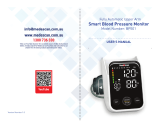17
5.9. Battery charge indicator
Batteries almost discharged
When the batteries are approximately 75% used, the
battery symbol will flash a few times as soon as the
instrument is switched on (if at least one of the batter-
ies still has some charge). Although the
instrument will
continue to measure reliably, you
should obtain replacement batteries.
Batteries discharged – replacements required
When the batteries are discharged, the battery symbol
will appear, unblinking, as soon as the instrument is
switched on. You cannot take any further measure-
ments and must replace the batteries.
1. Open the battery compartment on the bottom of the instrument.
2. Replace the batteries – ensure they are correctly connected, as shown
on the symbols in the compartment.
3. The memory retains all values although date and time (and possibly also
set alarm times) must be reset – the year number will flash automati-
cally after the batteries are replaced.
4. To set date and time, follow the procedure described in Section 4.3.
Note:
Use four new, Long-Life 1.5 V AA batteries. Do not use batteries beyond
their expiration date. If the monitor is not going to be used for a prolonged
period, the batteries should be removed.
Using rechargeable batteries
You can also operate this instrument using rechargeable batteries.
• Please use only type "NiMH" reusable batteries.
• If the battery symbol ( ) appears, the batteries must be removed
and recharged. They must not remain inside the instrument, as they may
become damaged through total discharge even when switched off. The
batteries must NOT be discharged in the blood pressure monitor. If you
do not intend to use the instrument for a week or more, always remove
the rechargeable batteries.
• Recharge these batteries using an external charger and follow manufac-
turer’s instructions carefully.




















